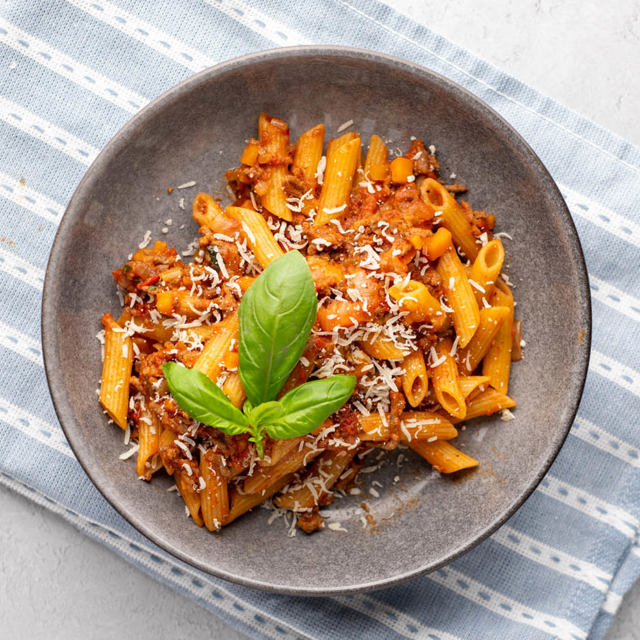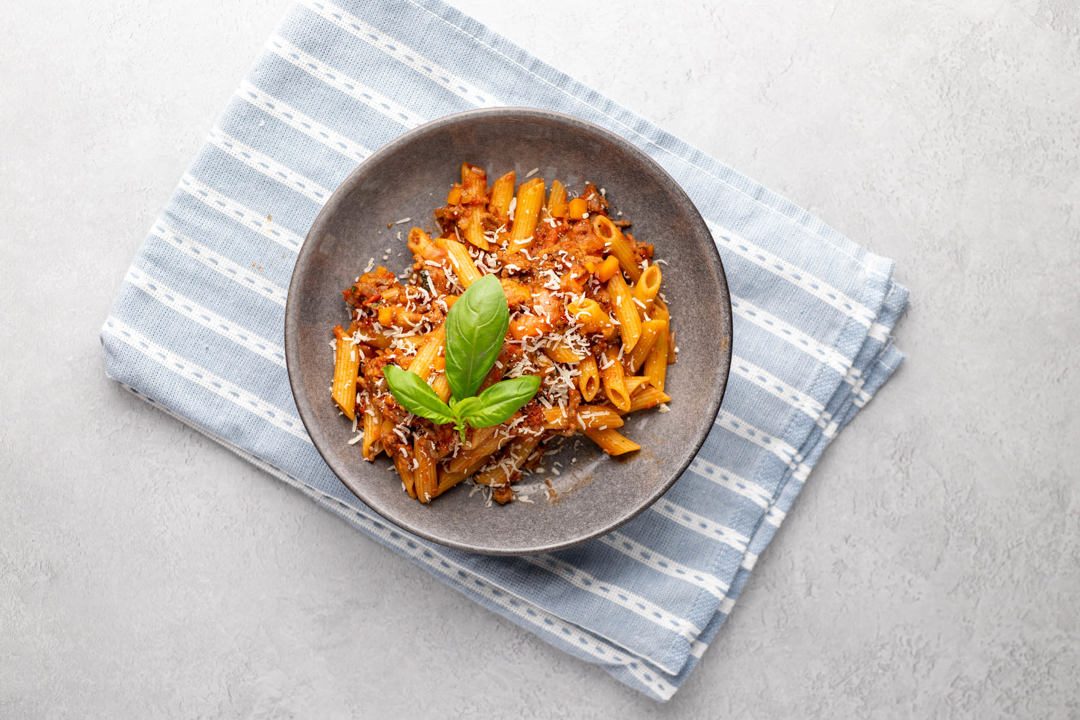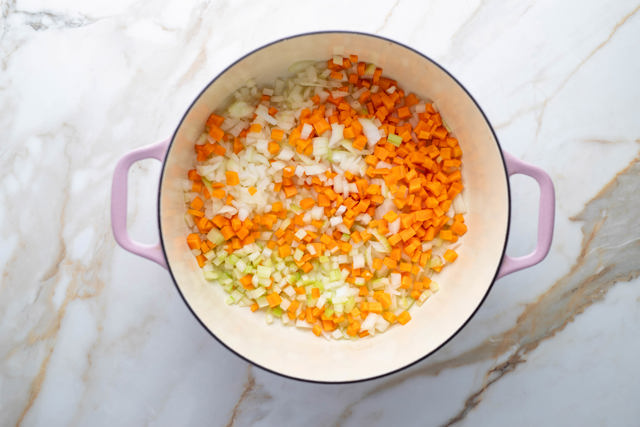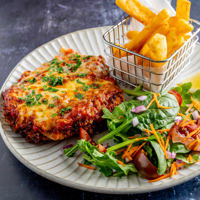The very first post I wrote for this blog was my Spaghetti Bolognese recipe. That recipe is my best Bolognese sauce and as such is complex, particularly when compared to this recipe. It also features more ingredients which adds to the cost and time taken to make it.
On the other hand, this quick and simple Bolognese sauce uses fewer ingredients and can be ready in about 30 minutes. As with my Spaghetti Bolognese recipe, the sauce benefits from being slow cooked for a longer time, so if you have some free time in the afternoon get the sauce on and let it blip away.
There are more hints and info in my Spaghetti Bolognese recipe, so you should check it out even if this is the recipe you're going to cook.
Simple Bolognese sauce ingredients
- Vegetables I use a variety of vegetables to provide a fantastic savoury base; celery, carrots, onion.
- Mince this tastes great with a mixture of pork and beef, or pork and veal. I'd suggest a ratio of 50/50 to 75/25 beef to pork. Don't use a super lean mince here, you want some fat for flavour. I've found that 80/20 to 90/10 mince works best.
- Garlic and basil are the main flavourings.
- Tomatoes the base of the sauce is tomato. Always use the best quality you can afford. I like the texture of diced tomatoes, but passata also works well; if you use whole canned tomatoes make sure you break them up.
How to make Spaghetti Bolognese
Mis en place – prepare the vegetables by dicing the onion, carrot, celery, separating the basil leaves from the stems and slicing them, and mincing the garlic.
Cook vegetables - sautee the onion, carrot and celery (1) over medium heat for 10 minutes, until the onions are translucent (2). Don't cook at a high heat so the vegetable gets browned.
Cook beef - add the beef (1) and break it up with your spoon. Cook for 10 minutes, stirring occassionally, until browned.
Garlic - add the garlic and cook for 30 seconds, stirring regularly, until fragrant.
Tomato and flavourings - add the tomato, bay leaves and basil stems. Use the edge of your spoon to scrape the bottom of your pan and deglaze it.
Cook - bring the sauce to a boil and then reduce heat to medium to maintain a slow simmer. Cook, uncovered, stirring every minute or so, until the sauce has thickened. If you find that the sauce is starting to stick to the pan, add a splash of water and scrape it off.
Cook pasta while the sauce is cooking.
Finish & serve - remove the bay leaves and basil stems, and add the sliced basil and sugar (if needed) to offset the bitterness from the tomatoes. The sauce should not be sweet. Season with salt and pepper. Serve with pasta, parmesan cheese, and optionally some extra basil leaves.
What to serve with Bolognese sauce?
Bolognese sauce is generally served with pasta. Spaghetti is the usual type of pasta, but penne or conchiglioni (shells) are common. It's a complete meal by with pasta, but you can make the meal more of an occasion with:
- An Italian-style garden salad
- Garlic bread
- Focaccia bread
- A simple Italian dessert, like Tiaramisu
Use whichever pasta you prefer, but avoid using very thin pasta like angel hair.
This is one pasta dish that I think works better with the sauce on top of the pasta, but you can absolutely combine the pasta and Bolognese sauce in a pan to finish it.
Oh... and you can't forget the parmigiano reggiano aka parmesan cheese. It takes the sauce to the next level! Wherever you can, use a decent Italian parmigiano – not all cheese are created equal.
Leftovers
Bolognese sauce freezes well, with and without pasta. You can easily make a larger quantity and freeze the leftovers!
Leftovers are also great for:
- Lasagne
- On top of some toast for a simple dinner
- Quesadilla filling – sandwiched between two flour tortillas along with some cheese as the filling and cooked in a frying pan
- Stuffed vegetables – capsicum/bell peppers, eggplant and zucchini
- As a baked potato topping along with some grated cheese
- Taco filling
- As a toasted sandwich filling
The sauce and pasta can easily be made ahead and reheated.
Sauce on top, or mixed through
The majority of the time I've eaten this, the sauce is on top of the pasta, including at restaurants. Ultimately it comes down to your preference, but if you'd like to sauce the pasta you can.
Instructions for saucing the pasta
Once the sauce is cooked and the pasta is mostly cooked, add 1 cup of the sauce per person to an appropriately sized pan. When the pasta is just before al dente, add a portion - around 150g to 200g cooked weight - to the pan with the Bolognese sauce using a spider or tongs, bringing pasta water along with you. Use tongs to thoroughly incorporate the meat sauce into the pasta and finish cooking the pasta, adding more water as needed to keep the sauce loose.

Quick and Easy Bolognese Sauce
| Prep | Cook | Total |
|---|---|---|
| 10 mins | 25 mins | 35 mins |
- 2 tbsp olive oil
- 2 onions, diced
- 2 carrots, quartered and diced
- 2 celery sticks, diced
- 500g beef mince or use a mixture of beef and pork - see note 1
- 2 cloves of garlic, minced if you love garlic, use more to taste!
- 2x 400g cans diced tomatoes or passata see note 2
- 2 dried bay leaves
- 10g Basil leaves, sliced, stems reserved
- Chilli flakes, optional
- Sugar, optional see note 3
- Salt & pepper, to taste
- Freshly grated parmesan cheese
- 400g spaghetti, penne or other dried pasta
- Fresh basil leaves
- Heat oil in a large frying pan or Dutch oven over medium heat.
- Cook the vegetables - add the onions, carrots and celery and cook for 10 minutes, stirring regularly. You don't want to colour the vegetables, but slowly sweat their water out.
- Cook the mince - increase heat to medium high and add the mince. Stir regularly and use your spoon or spatula that you're cooking with to break the mince up into small pieces. Cook for about 6-10 minutes until the mince is well browned and broken into small pieces.
- Add garlic - add the minced garlic and tomato paste and stir it through. Stir every 10 seconds until the garlic is very fragrant – should be about 30 seconds.
- Add tomato - add the tomato, bay leaves and the basil stems. Use your wooden spoon or spatula to scrape the bottom of the pan. Bring to a boil, stirring frequently, then reduce heat to medium.
- Cook sauce - simmer gently for 10-20 minutes, uncovered. Stir it occasionally while it's simmering and if looks a little dry or is starting to stick, add a splash of water and then use your spoon to deglaze the bottom of the pan. For a better result, you can cook the sauce for longer; see notes for details.
- Cook pasta - when the sauce is mostly done, cook the pasta according to packet instructions.
- Adjust seasoning - just before you're ready to serve, adjust the seasoning. Use some sugar to offset the bitterness of the tomato (if needed), add some chilli flakes if you want the kick, add sliced basil leaves and salt and pepper. Stir thoroughly whenever you add seasonings before tasting again – and take it slow, you can always add more but you can't take it out!
- Serve - remove the bay leaves and basil stems and serve with spaghetti, penne or pasta of your choice, topped with the Bolognese sauce and plenty of parmesan cheese.
- Mince - This tastes great with a mixture of pork and beef, or pork and veal. I'd suggest a ratio of 50/50 to 75/25 beef to pork. Use a ratio of 80/20 to 90/10 of lean to fat for the best result.
- Tomato – Preferably use either diced/crushed tomato or passata. If using whole tomatoes, make sure you break them up with your hand before adding them, or crush them with your spoon.
- Sugar – depending on how sweet your tomatoes are, you might need to add some sugar to offset the tartness of them. The dish should not taste sweet, but balanced.
- Long cook (oven) - cook, uncovered in the oven for 2 - 2.5 hours at 150C. Stir every 15 minutes and if it's starting to catch on the bottom of the pan add a little water and stir it through.
- Long cook (stove) - cook at a medium low temperature (4/10 on my stove) with the lid mostly on. Stir every 10 minutes until the sauce has thickened and reduced - around 1.5 hours. If it starts to stick to the bottom of the pan, add a splash of water.
- Food processor - feel free to use a food processor to speed up the prep of the vegetables. Pulse the celery, onion and carrot until they're in small pieces but not a paste.





























